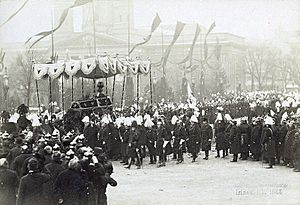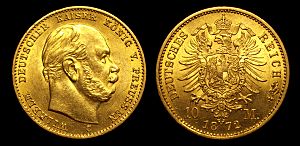William I, German Emperor facts for kids
Quick facts for kids Wilhelm I |
|||||
|---|---|---|---|---|---|
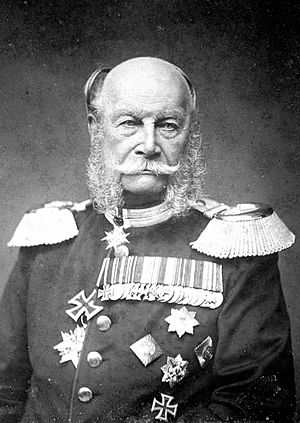
The Emperor in 1884
|
|||||
| German Emperor | |||||
| Reign | 18 January 1871 – 9 March 1888 | ||||
| Proclamation | 18 January 1871, Versailles | ||||
| Predecessor | Monarchy established | ||||
| Successor | Frederick III | ||||
| Chancellor | Otto von Bismarck | ||||
| King of Prussia | |||||
| Reign | 2 January 1861 – 9 March 1888 | ||||
| Coronation | 18 October 1861 | ||||
| Predecessor | Frederick William IV | ||||
| Successor | Frederick III | ||||
| Prime Ministers |
See list
|
||||
| Holder of the Bundespräsidium of the North German Confederation | |||||
| In office | 1 July 1867 – 31 December 1870 | ||||
| Chancellor | Otto von Bismarck | ||||
| Born | 22 March 1797 Kronprinzenpalais, Berlin, Kingdom of Prussia, Holy Roman Empire |
||||
| Died | 9 March 1888 (aged 90) Charlottenburg Palace, Berlin, German Empire |
||||
| Burial | 16 March 1888 Charlottenburg Palace |
||||
| Spouse |
Augusta of Saxe-Weimar
(m. 1829) |
||||
| Issue |
|
||||
|
|||||
| House | Hohenzollern | ||||
| Father | Frederick William III of Prussia | ||||
| Mother | Louise of Mecklenburg-Strelitz | ||||
| Religion | Lutheran (Prussian United) | ||||
| Signature |  |
||||
| Military career | |||||
| Allegiance | |||||
| Service/ |
(active service) |
||||
| Years of service | 1809–1858 (active service) |
||||
| Rank | Generalfeldmarschall (active service) |
||||
| Unit | 1st Guards Regiment | ||||
| Commands held |
|
||||
| Battles/wars |
|
||||
| Awards | Iron Cross | ||||
William I (born Wilhelm Friedrich Ludwig) was a very important leader in German history. He was the King of Prussia from 1861 and became the first German Emperor in 1871. He ruled until his death in 1888. William was part of the House of Hohenzollern, a famous royal family.
He became the leader of Prussia in 1858, first as a regent for his sick brother, Frederick William IV. Three years later, when his brother died, William became king. With the help of his chief minister, Otto von Bismarck, William led Prussia to unite many smaller German states. This led to the creation of the powerful German Empire. William was known for being polite and traditional. Even though Bismarck was very strong-willed, William was more open to new ideas than some other rulers of his time.
Contents
Early Life and Military Service
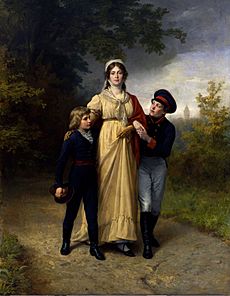
William was born in Berlin on March 22, 1797. He was the second son of Louise of Mecklenburg-Strelitz and Frederick William III of Prussia. Because he was the second son, no one expected him to become king. His older brother, Frederick William IV, was supposed to take the throne.
When William was 12, his father made him an officer in the Prussian army. He fought in the Napoleonic Wars starting in 1814. He was a brave soldier and earned the Iron Cross medal. These wars, especially the fight against France, greatly influenced him. He always had a strong dislike for the French.
In 1815, William was promoted to major. He fought in important battles like Ligny and Waterloo. After the wars, he worked as a diplomat. He also pushed for a strong and well-trained Prussian army.
In 1829, William married Princess Augusta. Their marriage was stable, but they were not always happy together.
In 1840, his older brother became King of Prussia. Since his brother had no children, William became the next in line to the throne. He was given the title Prince of Prussia.
Putting Down Revolts
During the Revolutions of 1848, there were many uprisings in German states. William helped put down a revolt in Berlin. He used cannons, which made him unpopular. People even called him "Prince of Grapeshot." He had to leave for England for a short time, dressed as a merchant. He later returned and helped stop another uprising in Baden.
In 1857, his brother, King Frederick William IV, became very ill and could no longer rule. In 1858, William became the Prince Regent, meaning he ruled in his brother's place. He promised to uphold the Prussian constitution. He also appointed a more liberal chief minister, starting a "New Era" in Prussia.
Becoming King of Prussia
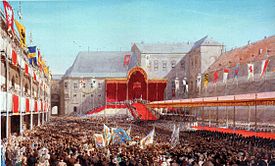
On January 2, 1861, Frederick William IV died, and William officially became King William I of Prussia. In July, someone tried to assassinate him, but he was only slightly hurt.
William crowned himself in Königsberg on October 18, 1861. This was a special event because it was the first Prussian coronation since 1701. It was also the only time a German king was crowned in the 1800s.
Working with Bismarck
William faced a problem with the Prussian parliament (the Landtag). They refused to approve money for his army reforms. William thought about giving up his throne. But his son, the Crown Prince, told him not to.
Then, William's Minister of War suggested he appoint Otto von Bismarck as Minister President. Bismarck was a strong conservative and a loyal friend of the king. He believed the Minister President should only answer to the king, not the parliament. Bismarck often got his way by threatening to resign. He became the real leader of Prussia's policies, both at home and abroad.
Wars and Unification
During his reign, William was the commander of the Prussian army in two important wars. First, the Second Schleswig War in 1864 against Denmark. Then, the Austro-Prussian War in 1866. Prussia won both wars.
After the war with Austria, William wanted to march on to Vienna and take over Austria. But Bismarck and William's son, Crown Prince Frederick William, stopped him. Bismarck wanted to end the war quickly so Prussia could be friends with Austria later. Frederick William was also upset by the many deaths. Bismarck even threatened to resign if William didn't agree. William finally gave in.
Prussia then took control of several states north of the Main River. In 1867, the North German Confederation was formed. This was a group of northern and central German states led by Prussia. William became its president and commander of its armies.
In 1870, during the Franco-Prussian War, William led all the German forces. They won a key victory at the Battle of Sedan.
German Emperor
During the Franco-Prussian War, the southern German states joined the North German Confederation. This group then became the German Empire. The title of president was changed to German Emperor (Deutscher Kaiser). William agreed to this on December 8, 1870. The new title became official on January 1, 1871.
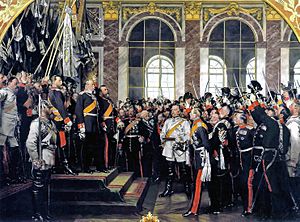
William was not eager to accept the new title. He worried it would make his title as King of Prussia seem less important. He also wanted to be called "Emperor of Germany." But Bismarck warned him that other princes might object. William finally agreed. On January 18, 1871, he was formally declared emperor in the Hall of Mirrors at the Palace of Versailles. This date was chosen because it was the coronation day of the first Prussian king in 1701.
Many people saw William's coronation as a return of the old Holy Roman Empire. Some even called him "Barbablanca" (whitebeard), like the medieval emperor Frederick Barbarossa (redbeard). A legend said Barbarossa slept under a mountain until Germany needed him. William I was seen as a new Barbarossa. The Kyffhäuser Monument shows both emperors.
William mostly let Bismarck handle the government. He focused on representing the state and usually approved Bismarck's plans. He once said about Bismarck, "It is difficult to be emperor under such a chancellor."
Assassination Attempts
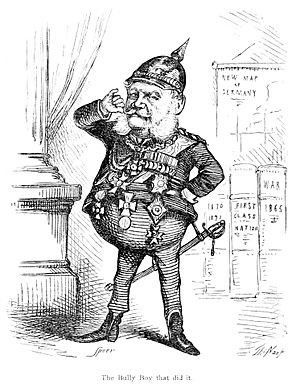
There were two attempts to assassinate William I in 1878.
- On May 11, a man named Emil Hödel shot at William's carriage in Berlin. The shots missed. Hödel was caught, tried, and executed.
- On June 2, another man, Karl Nobiling, shot William with a shotgun. William was badly hurt but survived. Nobiling died later from a self-inflicted wound.
Even though Hödel was not part of the Social Democratic Party, Bismarck used these attacks as an excuse to ban the party. He introduced the Anti-Socialist Law on October 18, 1878. This law made the Social Democratic Party illegal. It also banned many worker organizations and socialist newspapers. Social Democrats faced harsh punishments. These laws were renewed every few years. However, the Social Democratic Party still grew stronger. The laws were finally removed in 1890.
Later Years and Death
In 1878, William's nephew, Tsar Alexander II of Russia, complained about how Russia was treated at a meeting in Berlin. William, his wife, and his son traveled to Russia to fix things. Bismarck, however, wanted a closer alliance with Austria. William eventually agreed to the Dual Alliance between Germany and Austria-Hungary, which was aimed against Russia.
Another assassination attempt failed in 1883. Anarchists tried to use dynamite when William was at a monument unveiling, but the wet weather stopped their plan.
From 1884 to 1885, Bismarck organized the Berlin Conference. This meeting helped divide up territories in Africa and Oceania among European powers. Germany gained many new colonies, creating a large German colonial empire.
Despite the assassination attempts and his unpopular actions in 1848, William and his wife were very popular later in life. People saw them as symbols of "old Prussia." They liked their simple and modest way of living.
William died on March 9, 1888, in Berlin, just before his 91st birthday. He was buried at the Mausoleum in Charlottenburg Park. His son, Frederick, became emperor but was already very sick with throat cancer. Frederick ruled for only 99 days before he died. His son, William II, then became emperor.
Many memorials and statues were built across Germany to honor William I. More than 1,000 memorials were built between 1867 and 1918.
Family Life
William and Augusta of Saxe-Weimar had two children:
| Image | Name | Birth | Death | Notes |
|---|---|---|---|---|
 |
Frederick III, German Emperor and King of Prussia | 18 October 1831 | 15 June 1888 (aged 56) | married (1858) Victoria, Princess Royal; they had eight children. |
 |
Princess Louise of Prussia | 3 December 1838 | 23 April 1923 (aged 84) | married (1856) Prince Frederick of Baden; they had three children. |
Religion
William was a Lutheran and a member of the Evangelical State Church of Prussia's older Provinces. This church brought together both Reformed and Lutheran Christians.
Images for kids
See also
 In Spanish: Guillermo I de Alemania para niños
In Spanish: Guillermo I de Alemania para niños
- German Emperor
- List of monarchs of Prussia
- Berlin
- Germany
- Kamerun
- Togoland
- German South West Africa
- German New Guinea
- German East Africa
- German Samoa




